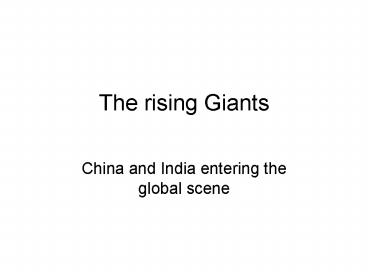The rising Giants - PowerPoint PPT Presentation
1 / 32
Title:
The rising Giants
Description:
Invasions, civil war. Cultural revolution. Nixon 'opens' China. Rockefeller ... From sleep to miracle. Massive increase in FDI. Open trade regime. Cheap labour ... – PowerPoint PPT presentation
Number of Views:22
Avg rating:3.0/5.0
Title: The rising Giants
1
The rising Giants
- China and India entering the global scene
2
China before 1949
- Landlessness
- Low technological level
- Low surplus
- Low subsistence capacity
- Low level of industrialisation
- Low incentives for trade
3
Chronology
Fall of Imperial China (1644-1911)
1911
Instability, Warlordism, Revolts, Invasions,
civil war
Communist party
1949
Collectivisation 1956 Stalinist model of
industrialisation Great leap forward New
Economic Policy
1950 1958
1961 1966
Cultural revolution Nixon opens
China Rockefeller follows suit
1972
1978
Market Reforms HRS, TVEs, FDI, WTO
2002
4
China since 1949
- The communist era (1949-1978)
- Great leap forward
- Cultural revolution
- Liberalisation (1978-2008)
5
China 1949-1978
- Planned economy
- Planning
- Resource allocation
- State and collective ownership
- Minimal private ownership
- Stalinist model for industrialisation
- Heavy industry
- Transfer of surplus from agriculture
- Closed economy
- Little foreign trade
- No foreign direct investments (FDI)
6
China 1949-1978
- Land reform
- New forms of organisation (cooperatives,
collectivisation, communes) - Taxation of agriculture
- Agricultural surplus source of capital
7
China 1949-1978
- Technological development, Phase 1
- Low income
- Weak markets and weak growth of markets
- Rural industries not driven by agricultural
demand
8
Agriculture in China, 1978 onwards
- HRS system introduced
- Communes abolished
- Private ownership
- Surplus for
- Investment
- Savings
9
Agriculture in China, 1978 onwards
- leading to
- Diversification
- Technological development
- Labour saving technologies (Phase 2)
10
Agriculture in China, 1978 onwards
- Labour release
- Rural industries
- Private savings invested in TVE
- Agriculture leads rural industrialisation
11
The role of agriculture in the miracle economies
- Food
- Foreign currency
- Capital transfer to industry
- Labour transfer to industry
- Market for industrial products
12
- Land reform (enables participation)
- Technological change
- Increased labour productivity
- Higher per capita income
- Higher purchasing power
13
Taiwan before WWII
- Colonial system
- New crops
- Higher production
- Higher yields (Phase 1)
- Low labour productivity (Not phase II)
- Low per capita income
- Small market
14
Taiwan After WWII
- Landreform
- New institutions (cooperatives for technology,
seeds, marketing, credits) - Technological change labour released
- Profit accumulation but not worse terms of trade
- Savings from agriculture to industry
- Market for the industrial goods
- Rural industries
- Agriculture the engine of growth
15
Industrial policy in Chinasince 1978
- Deregulation of markets
- Private ownership
- State owned enterprises are dismantled
- Mobile labour force
- Private capital markets
- New organisation requires new institutions
16
Reforms
- 1978 - A new discourse
- Encourage private initiatives (and profits)
- Accept inequity
- Encourage openness
17
The view on capitalism
- marginal gt
- supplement gt
- necessary supplement gt
- necessary component gt
- organic part
18
Reforms
- Production and trade is legalised
- Individual household enterprises (geti)
- Small scale
- Less than 8 employees
- Supplement to the socialist economy
19
Industrial policy in China, 1980s
- Private companies (siying)
- More than 8 employees
- Supplement to the publicly owned economy
- Property rights strengthened
20
Industrial policy in China, 1990s
- Household enterprises
- 31.6 million
- 62.4 million employed
- Private enterprises
- 3.2 million investors in 1.5 million companies
with 20 millon employed
21
(No Transcript)
22
(No Transcript)
23
From sleep to miracle
- Massive increase in FDI
- Open trade regime
- Cheap labour
24
(No Transcript)
25
(No Transcript)
26
From sleep to miracle
- Undervalued currency
- Market growth
- Education
- RD
27
Phases of development
- Phase 1
- State-led 1949-1978
- Stalinist
- Heavy industry
- Phase 2
- Agriculture-led -1980s
- Town and village enterprises
28
Phases of development
- Phase 3
- Technology-led 1990s
- Phase 4
- Knowledge-led?
29
Questions
- Pace of development
- Regions
- Rural-urban
- World economy
- Impact on China
- Impact on the west
- Impact on third world
- The environment
- The cost of development
30
(No Transcript)
31
(No Transcript)
32
(No Transcript)

